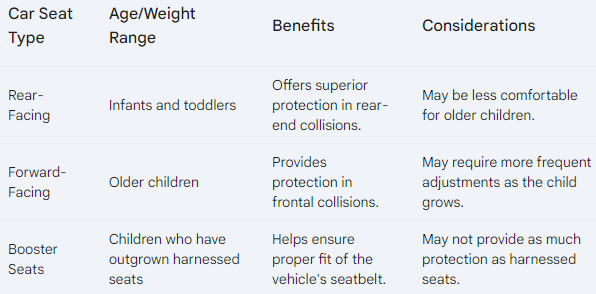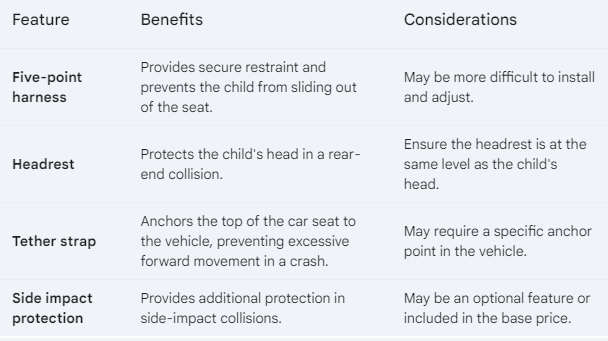How to Choose the Right Car Seat for My Child

As a parent, ensuring your child’s safety is your top priority. One of the most crucial decisions you’ll make is selecting the right car seat. With countless options available, it can be overwhelming to determine which one is the best fit for your family.
In this guide, we’ll delve into the essential factors to consider when choosing a car seat. From understanding the different types to ensuring proper installation and maintenance, we’ll equip you with the knowledge you need to make an informed decision.
Our goal is to provide you with practical advice and guidance so you can confidently choose the safest and most suitable car seat for your child.Let’s embark on this journey together and ensure your little one’s safety on every road trip.
Understanding Car Seat Types
There are three primary categories of car seats, each designed for specific age and weight ranges:
- Rear-Facing Car Seats: Suitable for infants and toddlers, these seats offer optimal protection in a rear-end collision.
- Forward-Facing Car Seats: Intended for older children who have outgrown their rear-facing seats, these seats feature a harness system.
- Booster Seats: Designed for children who no longer require a harness but need additional height to properly fit the vehicle’s seatbelt.

Additional Information
- Rear-Facing Car Seats: The AAP recommends keeping children rear-facing until they reach the maximum height and weight limits allowed by their car seat manufacturer.
- Forward-Facing Car Seats: Ensure the harness is adjusted correctly, at shoulder level, and snug.
- Booster Seats: Booster seats should have a high back and armrests to provide proper support.
- Car Seat Installation: Consider having a certified child passenger safety technician install your car seat.
- Tether Strap: If your car seat has a tether strap, use it to anchor the top of the car seat to the vehicle’s anchor point.
Impact of Car Seat Features

Key Factors to Consider
When selecting a car seat, consider the following factors:
- Your Child’s Age, Weight, and Height: Refer to the manufacturer’s guidelines to determine the appropriate car seat type.
- Car Seat Features: Look for features such as a five-point harness, a headrest, and a tether strap for enhanced safety.
- Ease of Installation: Consider the simplicity of installation and whether you’ll require professional assistance.
- Price: Car seats can vary significantly in price. Set a budget and adhere to it.
Tips for Choosing the Right Car Seat
- Conduct Thorough Research: Explore reviews, compare different models, and utilize resources like the National Highway Traffic Safety Administration (NHTSA) to identify the best options.
- Test Fit: Whenever possible, test the car seat in your vehicle to ensure a proper fit.
- Seek Professional Assistance: Consider having a certified child passenger safety technician (CPST) install your car seat. These technicians can provide expert guidance and ensure proper installation.
- Read the Manual: Carefully review the manufacturer’s instructions for proper use, maintenance, and installation.
Safety Considerations
- Adhere to Manufacturer’s Instructions: Always follow the manufacturer’s guidelines for installation, adjustment, and use.
- Avoid Front Seat Placement: Never place a rear-facing car seat in the front seat of a vehicle equipped with airbags.
- Ensure Proper Harness Adjustment: Verify that your child’s harness is adjusted correctly and securely.
- Inspect for Wear and Tear: Avoid using car seats that are damaged or worn.
Additional Tips
- Check for Recalls: Regularly check the NHTSA website for any car seat recalls.
- Avoid Secondhand Car Seats: Unless you have the complete history of the car seat, it’s generally safer to purchase a new one.
- Update Your Car Seat as Your Child Grows: As your child outgrows one car seat, make sure to transition to the appropriate size and type.
Local Resources
To find a (CPST) certified child passenger safety technician in your area, visit the NHTSA website or contact your local fire department.
Expert Insights
- Dr. Benjamin Hoffman, pediatrician: “The safest position for children is rear-facing as long as possible. It provides superior protection in a rear-end collision, which is the most common type of crash.”
- Sarah Jones, Certified Child Passenger Safety Technician: “Proper installation is crucial for car seat safety. If you’re unsure, seek professional assistance from a certified technician.”
- The American Academy of Pediatrics (AAP): The AAP recommends keeping children rear-facing until they reach the maximum height and weight limits allowed by their car seat manufacturer.
- The National Highway Traffic Safety Administration (NHTSA): The NHTSA emphasizes the importance of using car seats correctly and consistently to protect children from injuries in car accidents.
Statistics
- NHTSA data: According to the NHTSA, proper car seat use can reduce the risk of injury by 71% for infants and toddlers and by 54% for children ages 4 to 8.
- AAP data: The AAP reports that approximately 75% of car seats are either improperly installed or used incorrectly.
- Global statistics: Studies from around the world have consistently shown the effectiveness of car seats in preventing child injuries and fatalities.
Car Seat Laws and Regulations For USA
The laws and regulations regarding car seats in the United States can vary slightly from state to state, but there are some general guidelines that apply nationwide:
- Rear-Facing: Most states require children to be in rear-facing car seats until they reach a certain age, typically around 2 years old. However, the American Academy of Pediatrics (AAP) recommends keeping children rear-facing for as long as possible, ideally until they reach the maximum height and weight limits allowed by their car seat manufacturer.
- Forward-Facing: Once children outgrow their rear-facing car seats, they should be in forward-facing car seats with a harness until they reach a certain age, typically around 5 or 6 years old.
- Booster Seats: Children who have outgrown their harnessed car seats should use booster seats until they can fit the vehicle’s seatbelt properly. This typically occurs around 12 years old.
While these are general guidelines, it’s important to consult the specific laws and regulations in your state for the most accurate information. You can find your state’s car seat laws on the National Highway Traffic Safety Administration’s (NHTSA) website.
Conclusion
Choosing the right car seat is essential for your child’s safety. Follow these guidelines to make an informed decision:
- Research different car seats.
- Consider your child’s age, weight, and height.
- Seek professional help for installation.
- Always follow safety recommendations.
By following these steps, you can ensure your child’s safety on the road.
